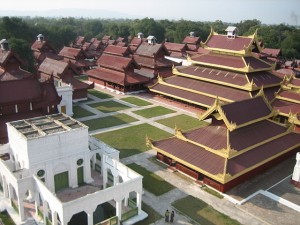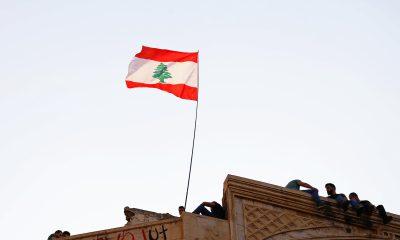Travel
Friendly residents, colourful customs make Myanmar a unique destination
MANDALAY, Myanmar – Jumping bumps and swerving around potholes, two dusty Canadians motorbiking toward an ancient spirit festival just up the road from Mandalay are practically greeted by a welcoming committee.
Burmese women with cherubic cheeks smeared golden with ground-bark makeup rattle shiny silver pots. A boy of about 10 nearly tumbles into the road, teetering on one foot to score high-fives from the scooting passersby.
Plastic-horn blasts herald their arrival among the throngs. Coconut-coated sweets are gifted by cross-legged hawkers with Libra scales. A whirlwind of neon scarves sweeps the duo into a crush of hugs and flying roses and frenzied ceremonial dancing.
A photo-snapping duel ensues. Locals, who’ve congregated this steamy afternoon to party hard in the tiny village smack dab in the centre of Myanmar, are curious and elated by their alien visitors.
“What country you come from?” is the common ice-breaker.
It’s the reception foreign travellers often get.
Shuttered for 50 years until recently by a repressive military regime, the Southeast Asian country also known as Burma is a quirky tapestry of huge-hearted people yearning to connect with the rest of the planet.
Though the rapidly reforming nation likely still seems a dauntingly elusive destination from the vantage point of Joe Canadian, that perception appears to be changing owing to spreading word-of-mouth about truly unique sojourns.
“Everything is really as if it’s locked in a time capsule,” said Karen Butler, a long-time Toronto resident who journeyed through Myanmar for three weeks in January.
“People approach very openly. They want to speak with you. They want to practise their English. They are really interested in asking questions about you and the outside world. They’re very friendly, very smiley.”
It’s now been more than three years since the country that shares many climate and cultural similarities with neighbouring Thailand opened its polls and released from house arrest Nobel Peace Prize winner Aung San Suu Kyi. The government’s reforms won it improved ties with Western countries, jump-starting tourism.
More than one million foreigners visited Myanmar in a single year for the first time in 2012, according to the country’s hotels and tourism ministry. Among them, 6,485 were Canadian.
Finally on the map, the number of visits to Myanmar is expected to keep climbing. Friction between the moving parts of an entire society being rejigged, however, is already changing the nation, both for better and for worse.
Hence why sooner rather than later is best to high-tail it to the luscious land of rice paddies and the mighty Irrawaddy River, equally replete with pagodas gleaming like gold thimbles when seen from the sky and omnipresent Buddhist monks wrapped in maroon robes.
Indiana Jones’-sized courage is not required. Despite the lack of infrastructure and a well-needed deep clean, with just a few preparatory steps, such as a visa, the right money and necessary immunizations, Myanmar’s must-sees can be journeyed to safely and in relative comfort.
Two billboards, erected side by side outside Yangon’s airport, simultaneously advertise the country’s popular Myanmar Beer – “Warmly welcome our country, our brand” – and state in stark lettering: “Drug offense is a serious crime and it can get the death penalty.
”
There are definite rules to be followed here, but if visitors abide by them (such as by staying only at designated guesthouses) their holiday will be smooth and intoxicating. They’ll experience colourful customs (double-smooch the sky to get service), a strong activist subculture (political cartoons have a long history) and cuisine representing Myanmar’s vast ethnic diversity (point-to-pick Shan joints, wild-gathered Kachin salads, Burmese noodle soups).
The pulse of progress is strongest in modernizing Yangon, a wacky city with cabbies driving cars with the steering wheel on the wrong side, vendors dangling Aung San Suu Kyi T-shirts and chi-chi shisha bars frequented by the children of infamous cronies.
Purchase handicrafts and traditional longyi sarongs in the labyrinthine Bogyoke Aung San (Scott) market, stroll in daytime around the hoard of treasure that is 2,500-year-old Shwedagon Pagoda and join the crowd gorging on skewers of barbecued meat for dinner on 19th Street.
Travellers’ next move should involve either busing or flying to Mandalay, another former capital, where historic sites worthy of lengthy queues can instead be enjoyed in princely peace.
Run fingers along 1,774 marble slabs inscribed with Buddhist text – dubbed the world’s largest book – and climb barefoot up Mandalay Hill to reach a breathtaking panorama. Many visitors avoid the imposing palace compound, which was reconstructed by forced labour in the early 1990s.
Onwards comes the choice of tried-and-true route via sea or air to the archeological ruins in Bagan – an awesome moonscape of countless crumbling temples explored by foot or hot-air balloon – and then touristy Inle Lake. For the more adventurous, trekking in the mountains around the Shan state towns of Hsipaw, Kalaw and the little-visited Kyaukme offers stunning vistas and profound cultural encounters.
Travellers seeking serenity on their own terms might also fly to the northernmost accessible city of Myitkyina, not dangerous though located in conflict-ridden Kachin state. It’s also the jumping-off point to Indawgyi Lake – open to foreigners but rarely visited.
Late summer, the view overlooking the irrepressible Irrawaddy River from open-air Jingpo Duu restaurant is a dreamscape of wispy mashed-potato clouds just eclipsing distant mountains. Two temples shine like new pennies on the opposite shore.
Tourists would pay a premium for such picture-perfect dining in Canada, suggests resident John Sanlin.
“Not here. This is not like Yangon. There are no traffic jams,” he says, gesturing across the river. “If you have time, go to the frontlines. Sleep with the soldiers. One candle, then bed.”
Hospitality right to the finish.
Follow (at)TamsynBurgmann on Twitter.
___
If You Go…
VISA: The most common gateway to Myanmar is Yangon, the former capital once called Rangoon. A tourist visa must be obtained from a Myanmar embassy before touchdown. Budget airlines also connect Mandalay, Myanmar’s second biggest city, to Bangkok and Singapore.
MONEY: Most crucially, carry in the amount you expect to spend in the form of new U.S. hundred-dollar bills. Ensure no creases or tears before exchanging on arrival for towering stacks of Burmese kyat. Credit cards are rarely accepted. The few hundred internationally linked ATMs can be hard to find and are not always reliable.
HEALTH: Consult a doctor for recommended vaccines at least six weeks before departure. Bring travel medication.
SECURITY: Although Myanmar is generally an exceptionally safe destination, the Canadian government advises prospective travellers to exercise a “high degree of caution” – the same status accorded to India and Brazil. Warnings mainly pertain to regions unlikely on a first-timer’s itinerary. Violent crime against tourists is rare. Visit travel.gc.ca/destinations/burma-myanmar
























